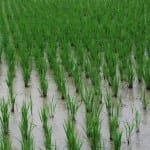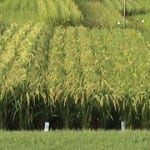 Readers are likely aware that I publish another newsletter, Sake Industry News, thanks to the liberal use of ads in this publication. In every other issue of SIN, we publish an interview with a brewer that consists of ten questions about the brewing season. Last issue, we published such an interview with a brewer that was chock full of interesting insights. (To find out who, please subscribe to Sake Industry News! You’ll be glad you did!)
Readers are likely aware that I publish another newsletter, Sake Industry News, thanks to the liberal use of ads in this publication. In every other issue of SIN, we publish an interview with a brewer that consists of ten questions about the brewing season. Last issue, we published such an interview with a brewer that was chock full of interesting insights. (To find out who, please subscribe to Sake Industry News! You’ll be glad you did!)
One of the questions we asked him was, “How was production volume this year compared to last year? Up, down or the same?” His answer was that it was about the same. However, he went on to say that due to COVID19, sales have slumped significantly.
“We may have to reduce volume over the next few years. We’ve already committed to our rice purchase for next year so we won’t be able to adjust until the year after. It’s really quite scary!” he continued.
Just how challenging this can be for sake brewers – and rice growers too – might not be evident to most people, so let’s look at it here.
Naturally, all sake brewers want stable businesses, and most want to grow their business as well. And naturally enough they need to balance supply and demand. If they run out of product, consumers will run to other producers. But if they make too much sake, more than can be reasonably sold, it runs the risk of getting old and suffering in quality. In truth, there a dozen ways to mitigate the problem of having too much sake on hand, but not letting the problem arise in the first place is better than any of them.
So balancing what they think they can sell with how much they produce is a big part of running a sake-brewing business. There is much to take into account: trends, plans, stock on hand, economic environments and more will all affect sales. But after assessing what they think they can sell and how much they need to brew, they order rice.
Bear in mind with very, very few exceptions sake brewers do not own rice fields or grow their own rice. And even among those that do, no brewer grows all the rice needed for a full year’s production. Instead, they order it from farmers, usually through agricultural cooperatives but sometimes by direct contract.
 Rice-growing is a whole ‘nother industry in Japan, with its own challenges. Naturally, farmers want to grow as much as they are legally permitted, but also need to be able to sell that rice easily. And like sake brewing, that calls for a whole lot of planning. Rice is harvested in the fall, but planting begins in the spring, somewhere between March and June. Planning just what rice will be grown where, and, for many farmers, how much will be sake rice and how much eating rice or even rice for some other use must all be planned way in advance.
Rice-growing is a whole ‘nother industry in Japan, with its own challenges. Naturally, farmers want to grow as much as they are legally permitted, but also need to be able to sell that rice easily. And like sake brewing, that calls for a whole lot of planning. Rice is harvested in the fall, but planting begins in the spring, somewhere between March and June. Planning just what rice will be grown where, and, for many farmers, how much will be sake rice and how much eating rice or even rice for some other use must all be planned way in advance.
What that means is that sake breweries place rice orders in February or so for rice for the following fall. Remember, every year is different. It might be a bumper crop, but yields might be much lower than usual. And much can change between the time rice is ordered and the time it hits the market a year later. Lots of things might change. Like COVID, for example.
And that is what happened this year. Brewers looked at things like sales trends up until February, and made decisions on how much sake rice to order. But due to COVID, overall sake sales in March dropped about 13 percent, and some individual brewers saw drops of 40 and 50 percent of shipments in March and April. Naturally, this would drastically drop the amount of rice one would normally order, but the orders were already in.
 Modifying those orders is not a simple thing. In fact, sometimes it is just not possible. So much goes into the planning of how much rice and which rice will be grown where that it simply cannot be changed quickly. If a field in which sake rice was grown all of a sudden is used for another agricultural product, it is very difficult to change it back to sake rice. It just doesn’t work that way.
Modifying those orders is not a simple thing. In fact, sometimes it is just not possible. So much goes into the planning of how much rice and which rice will be grown where that it simply cannot be changed quickly. If a field in which sake rice was grown all of a sudden is used for another agricultural product, it is very difficult to change it back to sake rice. It just doesn’t work that way.
Some might think that another solution would be, rather than ask a farmer to just grow another rice, instead just say, “cancel the order, and let the field be empty this year,” but apparently that is even worse.
So in many cases, the brewers will be stuck with the rice that was ordered, and that is why it is “quite scary” to our interviewed brewer.
In truth, there are a handful of potential solutions. The rice can be stored at cold temperatures and used later – but the energy costs are significant. The brewed sake can be made in such a way that it stands up to time in the bottle better, stored colder than normal to slow down maturation (at a cost, of course!) and sold later than originally planned. And then, if need be, the following year’s production can be planned around the surplus.
But the rice-growing industry might not be able to adapt as fast.
In truth, it is a fairly intricate problem involving several industries, and it also depends on the whims of nature and the economic environment. Just how it will pan out, of course, remains to be seen. Stay tuned!
So the problem is complicated. But the solution is the same: all of us need to drink more sake. If we can enjoy more sake and nudge demand up steadily in spite of all that is happening in these times, we are doing our part, and all that we can to help the sake industry.
And speaking of Sake Industry News, why not subscribe today! Learn how to do that below.
Also check out my Sake Education Video Channel on YouTube here:

~~~~~~~~~~~~~~~~~~~~~~~~~~~~~~~~~~~~~~~~~~~~~~~~~~~~~~~~~~~~~~~~~~~~~~~~~~~~~~~~~~~~~~~~~~~~
 Know more. Appreciate more.
Know more. Appreciate more.
Interested in learning more about sake, and the industry in Japan that makes it? Subscribe to Sake Industry News, a twice-monthly newsletter covering news from within the sake industry in Japan. Learn more and read a few sample issues here.
~~~~~~~~~~~~~~~~~~~~~~~~~~~~~~~~~~~~~~~~~~~~~~~~~~~~~~~~~~~~~~~~~~~~~~~~~~~~~~~~~~~~~~~~~~~~





